Flowering plants represent most of the plants living on Earth today. They are crucial members of virtually every ecosystem on the planet, providing habitat and food for countless animal species. More than just a resource, however, flowering plants fill the natural world with color and beauty in every season. In this article, we’ll look at 30 species of blue wildflowers that grow free and wild across the globe and learn some interesting facts about each one.
1. New England Aster (Symphyotrichum novae-angliae)

©John Byers/ via Getty Images
The New England aster belongs to a large genus of over 90 species, most of which appear throughout North America. This species in particular is very showy, producing ample blue-purple to pink composite flowers in the late summer and early fall. Despite its common name, this aster isn’t limited to New England and appears in 42 of 50 U.S. states as well as much of Canada.
2. Payette Penstemon (Penstemon payettensis)

On the other end of the distribution spectrum, the Payette penstemon grows in only three northwestern U.S. states — Idaho, Montana, and Oregon. These beautiful, blue, snapdragon-like wildflowers appear on two-foot-tall stems that rise high above their basal foliage. They are sensitive plants that do not tolerate trampling or soil compaction, so observers should take care not to disturb them.
3. Round-lobed Hepatica (Anemone americana)

©Pandur/Shutterstock.com
This species of anemone, formerly considered a subspecies of Hepatica nobilis, appears in woodland environments in 31 U.S. states. These anemones bloom very early in the spring, producing their flowers directly from their underground rhizomes. Look for tiny, blue wildflowers with 5 to 12 petals hovering just above the forest floor. Throughout most of the year, they are easy to identify by their unusual tri-lobed leaves, which resemble swollen, waxy clovers.
4. Blue Toadflax (Nuttallanthus canadensis)

©J K Laws/Shutterstock.com
If you live east of the Mississippi, look for these lanky members of the plantain family in the summer, from May to July, as their baby blue blooms spring up through their low-lying foliage. The tiny flowers grow in clusters from the tips of their exceptionally long talks and are easy to spot as they wobble in the breeze. The species can be difficult to distinguish from its close relatives, and some rely on location for a clear identification.
5. American Bellflower (Campanulastrum americanum)

The American bellflower produces its flowers from the axils of its leaves, which reduce in size as gradually as they approach the apex of the plant. The blooms are stunning, with five fused, blue petals that feature a white ring with a long, pale pistil at its center. Despite their common name, these flowers are almost entirely flat instead of bell-shaped. Those in eastern Canada and the eastern United States outside of New England can catch these unique wildflowers blooming throughout much of the summer.
6. Appalachian Bellflower (Campanula divaricata)

Unlike the American bellflower, this species is true to its common name. This southeastern species, part of the genus Campanula, produces a multitude of tiny, blue to purple downturned flowers. The tiny petals curl back toward the calyx with the pistil hanging below, giving them the exact likeness of tiny bells. In the late summer, they pop up sporadically throughout the Appalachian mountain range on rock outcroppings, open woodlands, and sunny hillsides.
7. Blue-eyed Mary (Collinsia parviflora)

©Kevin Oke Photo/Shutterstock.com
Among the smallest blue wildflowers is the blue-eyed Mary. Its specific name, parviflora, which means “with small flowers” turns out to be very accurate. These ground-cover plants produce extremely tiny blooms, which measure only an eighth-inch across on average. This species begins flowering very early in the spring when it can be seen growing in large colonies throughout western North America. It also appears infrequently in the eastern states, like Vermont and Massachusetts.
8. Virginia Bluebells (Mertensia virginica)

©Liz Albro Photography/Shutterstock.com
Where the blue-eyed Mary is most prevalent in the western U.S., the Virginia bluebell appears throughout most of the eastern states. In the early spring, these flowers pop up ephemerally in moist woodland environments and seasonal floodplains. Though their flowers are pink when they emerge from their buds, they generally turn a gentle shade of sky blue when they open. Tragically, due to flood prevention and habitat destruction, Virginia bluebells are becoming less common throughout their native range.
9. Plains Bluehearts (Buchnera americana)
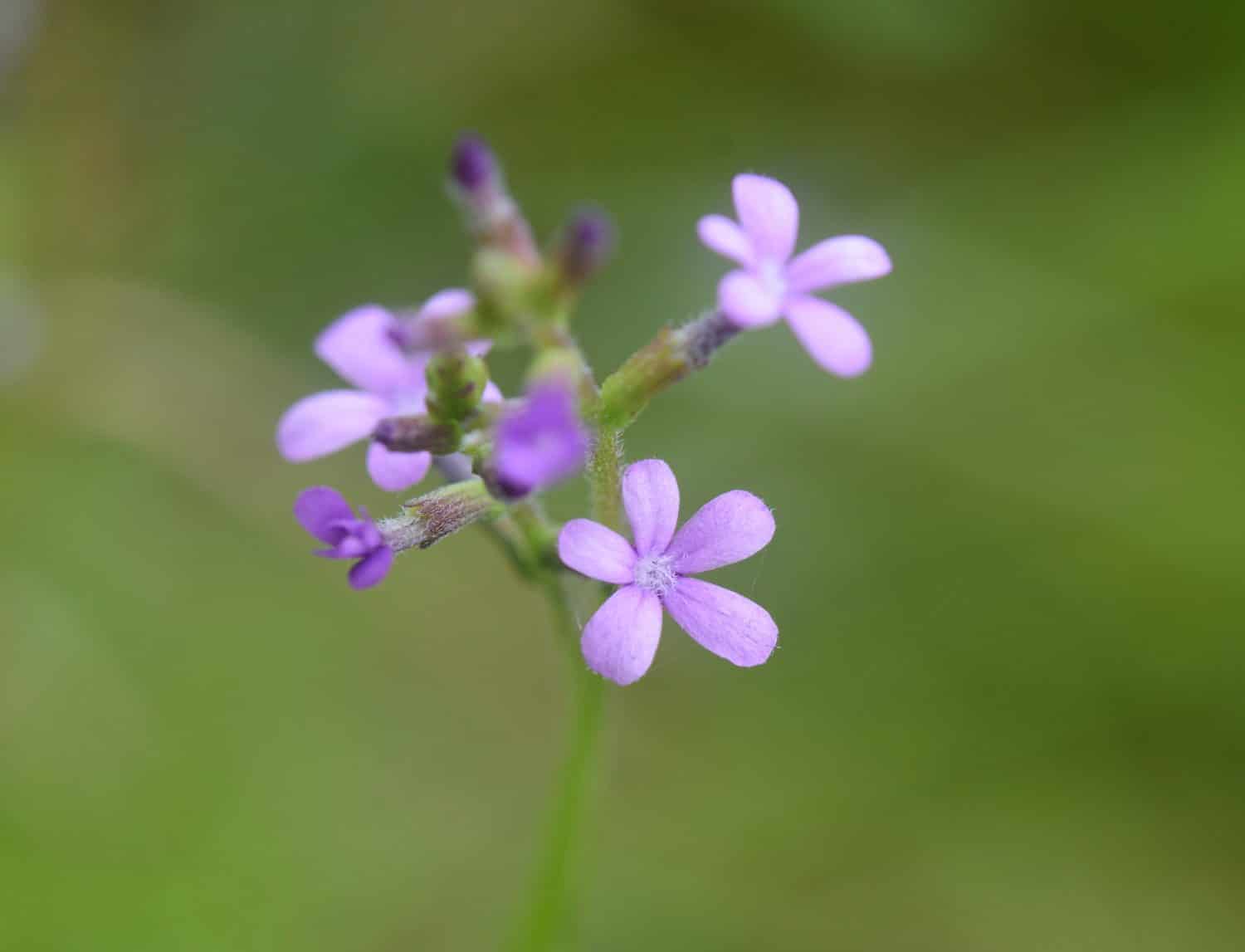
©Judy M Darby/Shutterstock.com
The plains blueheart is a particularly beautiful species of blue wildflower. It occurs throughout eastern North America but is declining and even faces endangerment in some locations. While once more abundant in Ontario, there are only a few small populations that exist there today. Interestingly, plains bluehearts are hemiparasitic. Though they can photosynthesize their food, they can also tap into the roots of neighboring plants to supplement their nutritional needs.
10. Sea Holly (Eryngium maritimum)
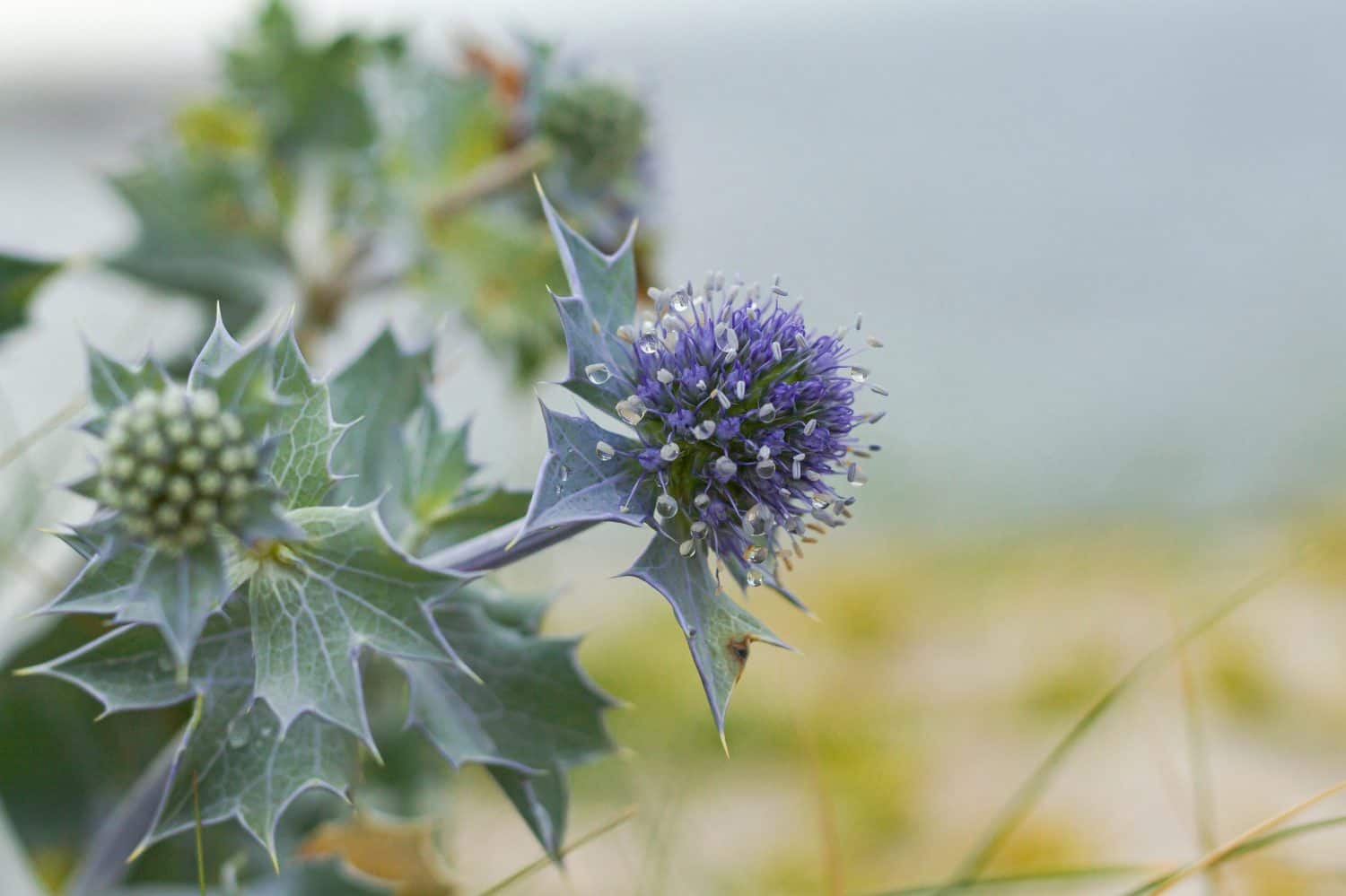
©Sebilense/Shutterstock.com
The sea holly is a European member of the carrot and parsley family, Apiaceae. It pops up in open, sandy areas and rocky coastlines where winters are mild. It has bright, waxy leaves that protect the plant from excess sunlight and help retain water when rainfall is scarce. Unfortunately, like the Virginia bluebell, these beautiful and unique wildflowers are becoming scarce across most of Europe. In some locales, populations have already been completely extirpated.
11. Wild Hyacinth (Camassia scilloides)
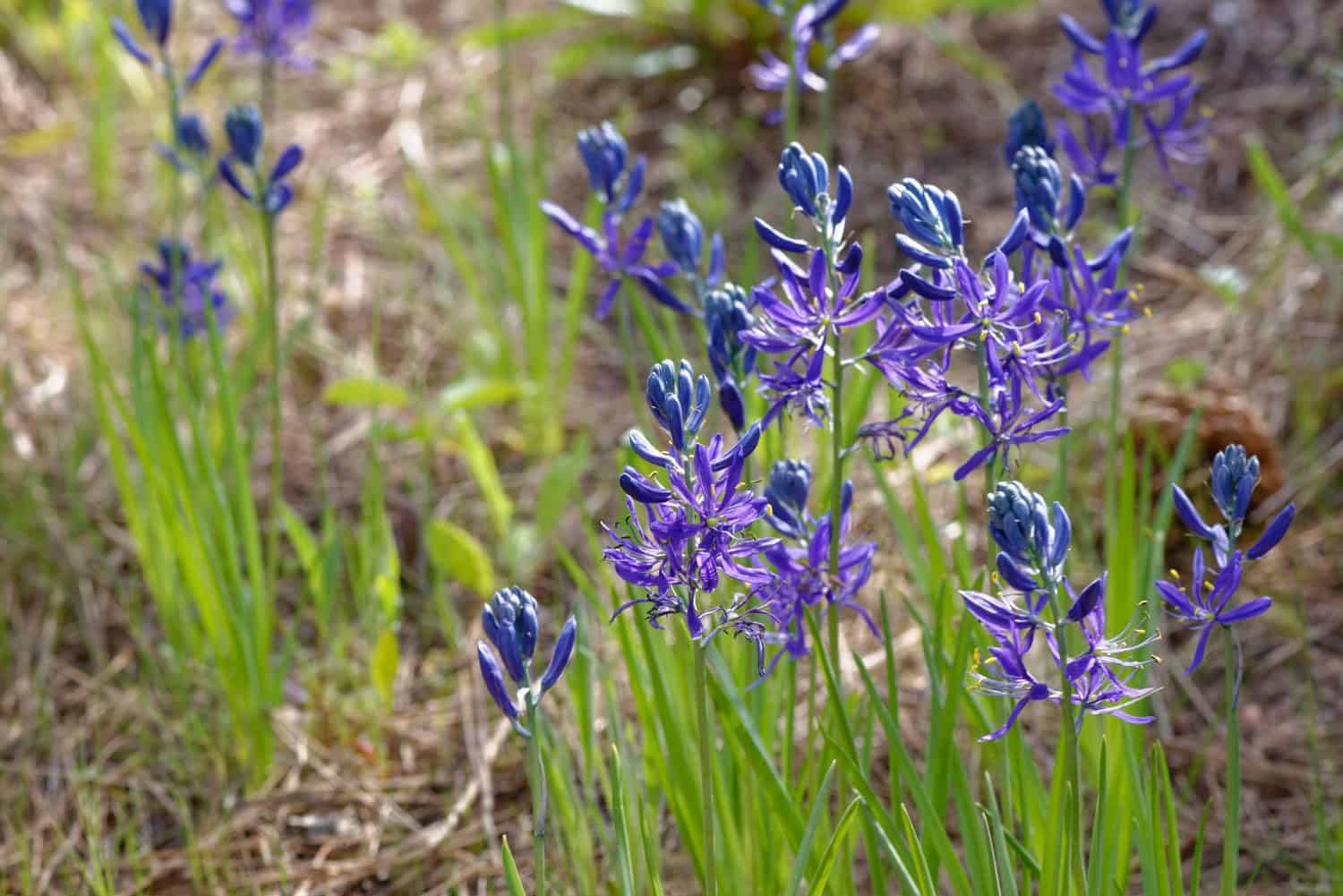
©Walter Erhardt/Shutterstock.com
Although they may resemble scillas, wild hyacinths are, in fact, very different plants. Where the Siberian squill (Scilla siberica) is highly toxic, the bulbs of these blue wildflowers are entirely edible and serve as a very important food source for several groups of Native American peoples. Foraging for the species can be difficult, however, as they superficially resemble their equally beautiful but deadly cousins, the death camas (Zygadenus nuttallii).
12. Chickory (Cichorium intybus)
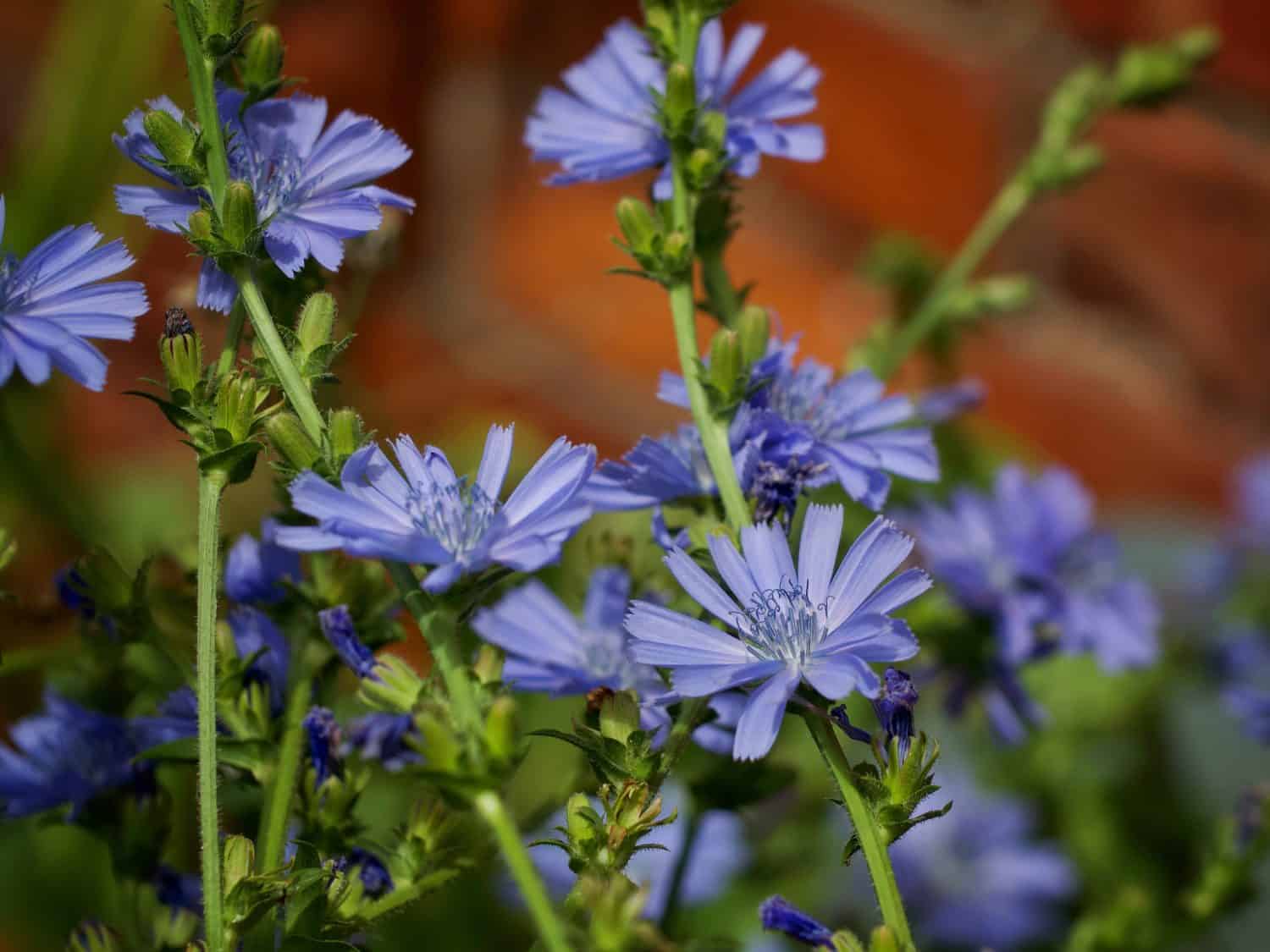
©Pefkos/Shutterstock.com
Once limited to Europe, North Africa, and western Asia, early colonizers of North America carried the species with them across the ocean. It has since naturalized throughout the United States and Canada, as well as China and Australia. In the wild, chickory bears its small, sky-blue or lavender composite flowers on tall stalks from late spring to early fall. The entire plant, including the flowers, is edible and many varieties grow in cultivation today. Belgian endives and radicchio are both common cultivars of chickory.
13. Prairie Flax (Linum lewisii)
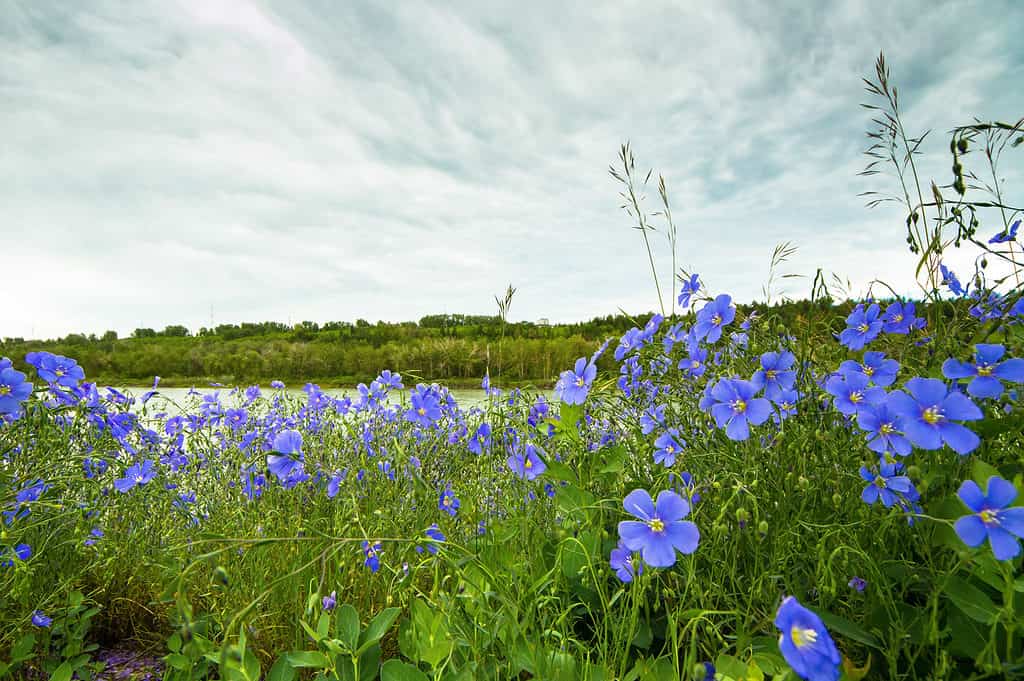
©SWP222/Shutterstock.com
Prairie flax is a North American native that appears throughout the western three-quarters of the United States and Canada. The flowers, which begin to bloom in late spring, have five pale-blue petals with dark blue venation. By the time the plant matures, it has shed most of its narrow leaves, leaving behind only flowerhead clusters that lean on their long stalks.
14. Breadroot (Pediomelum subacaule)

©Donna Bollenbach/Shutterstock.com
Also known as scurfpea or glade potato, these intricate deep purple or blue wildflowers produce edible, tuberous roots that provide a great source of starch. While plants of this species were once an important food source for native peoples in the southeastern United States, they are today quite rare. This breadroot species grows only in narrow bands of limestone cedar glades in central Tennessee, northern Georgia, and Alabama. The flowers bloom in the late spring on long, leafless stalks, but fade by late summer as the glades dry out.
15. False Pennyroyal (Trichostema brachiatum)
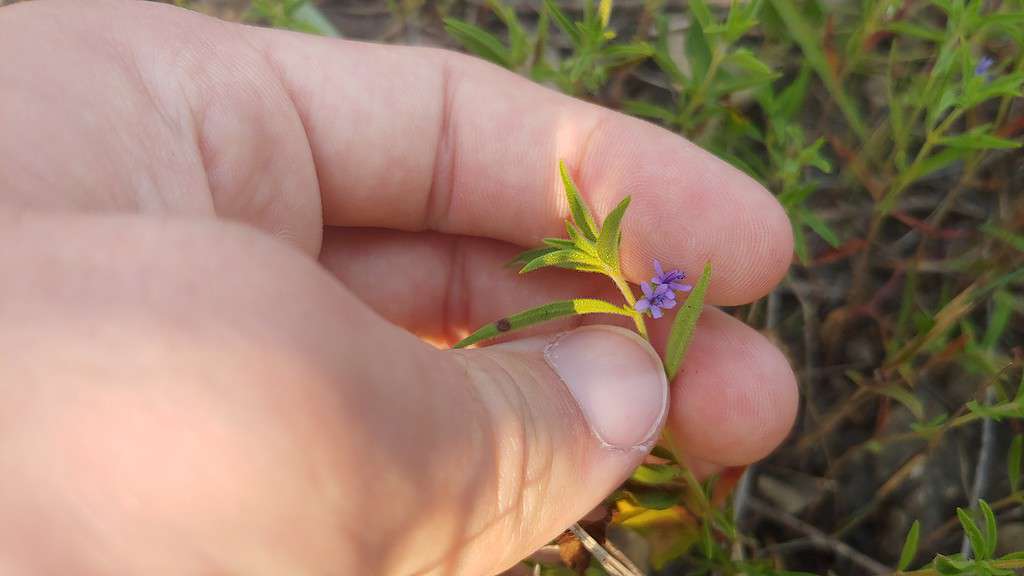
These tiny blue wildflowers, which rise about 18 inches above the ground at maturity, appear throughout most of the central and eastern United States. In some states, however, false pennyroyal is facing rapid decline. It is endangered in Connecticut, Massachusetts, Michigan, and New Jersey, and is exceedingly rare in the rest of New England.
16. Small Camas (Camassia quamash)
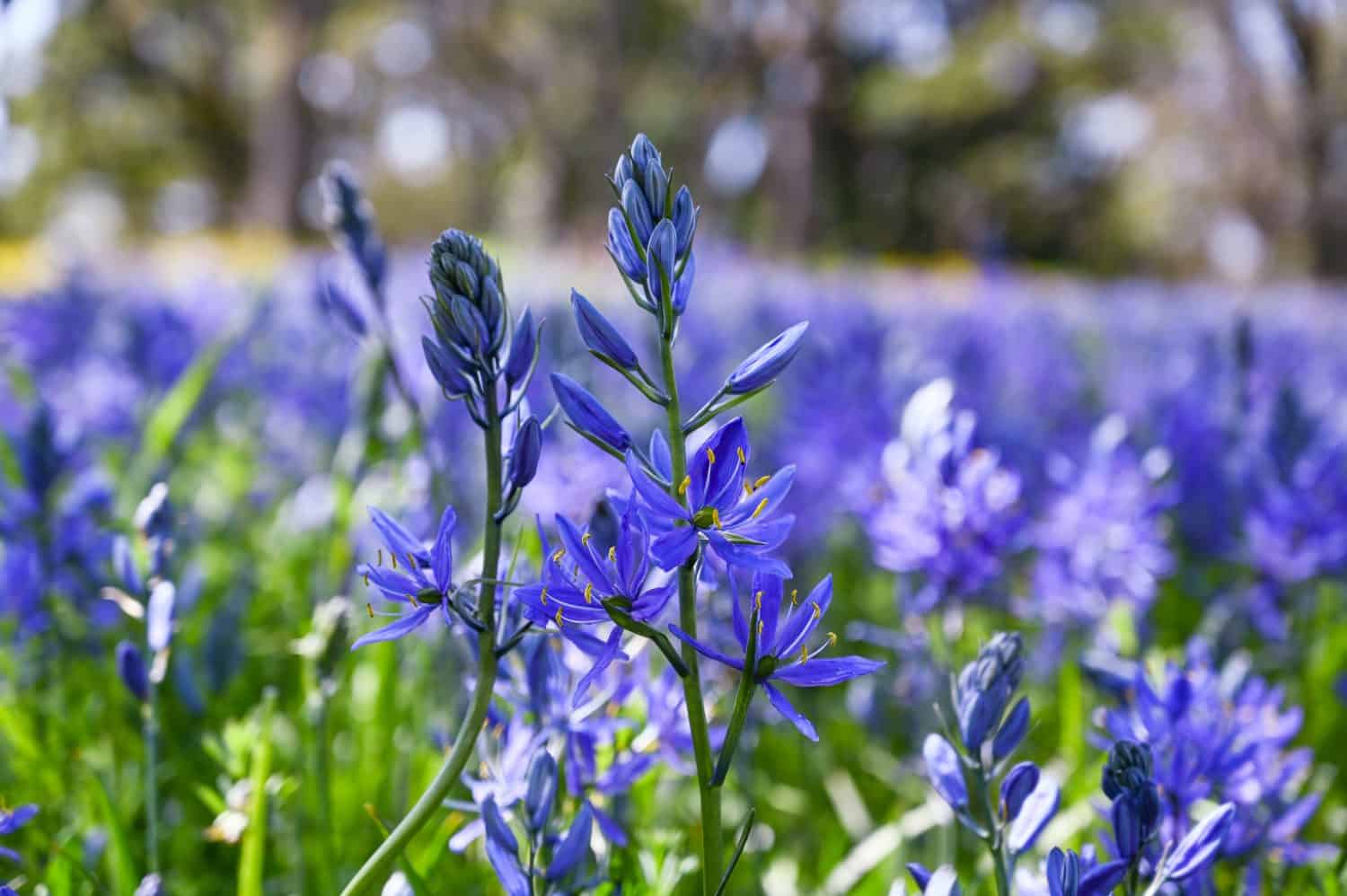
©WhisperingOaksPhotography/Shutterstock.com
Like its cousin, the wild hyacinth, the bulbs of this camas species are edible and serve as an important food source for Native American peoples in its growing range. This species, however, is limited to the western and northwestern United States and Canada, appearing in only a handful of states and provinces. In continued similarity to the wild hyacinth, this species also closely resembles the death camas and should be treated with great care.
17. Blue-eyed Grass (Sisyrinchium angustifolium)
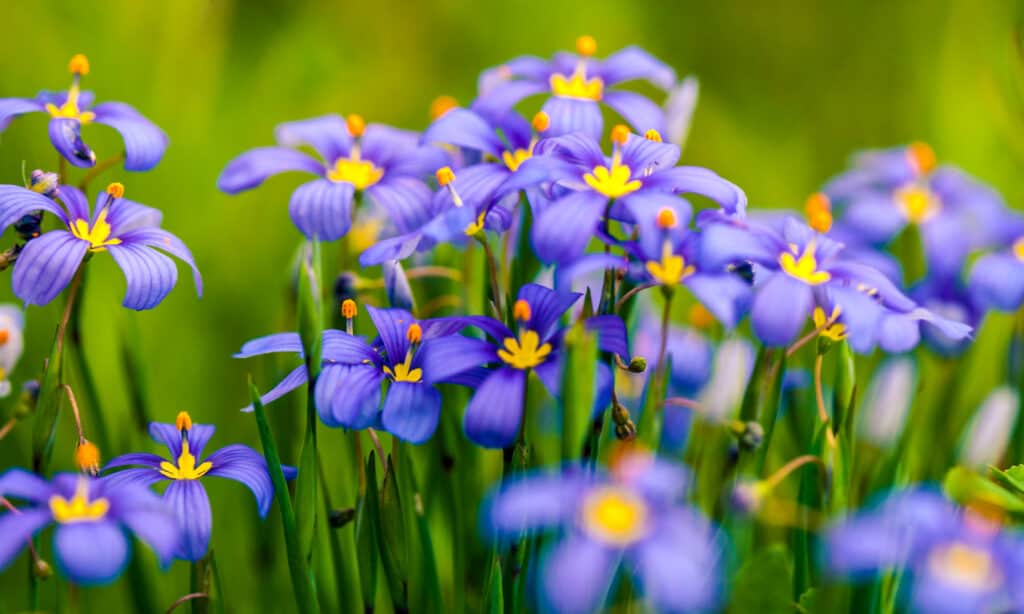
©Moab Republic/Shutterstock.com
Though it is referred to as a grass, this Sisyrinchium species belongs to the iris family, Iridaceae. It derives its name from its narrow leaves and long, grass-like stems. Where grasses don’t generally produce conspicuous flowers, this species presents numerous delicate, star-shaped blooms with striking yellow centers. Blue-eyed grass grows in most of the United States and in several Canadian provinces.
18. Mountain Kittentails (Synthyris missurica)

©Marina Poushkina/Shutterstock.com
This adorable species of blue wildflower gets its common name from its cylindrical inflorescences which, from a distance, resemble groups of fluffy kitten tails. Mountain kittentails are quite rare, appearing only at high elevations in five northwestern U.S. states. They bloom very early in the year, immediately following snowmelt in the spring. Sometimes, they will even bloom before the snow has completely melted away.
19. Wild Comfrey (Cynoglossum virginianum)
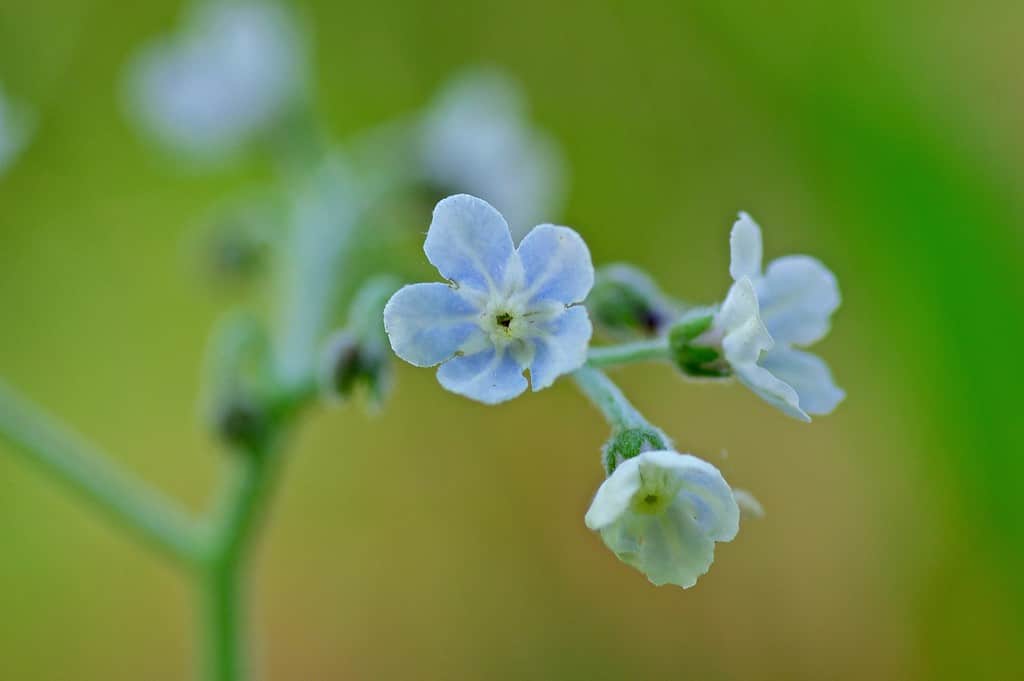
Wild comfrey is a tiny but visually striking blue wildflower that has historically been prominent in the entirety of the eastern United States. However, in recent years, the species has declined in nearly all of the northeastern states. It appears on the endangered list in many of them and has completely vanished in Pennsylvania and Ohio.
20. Carolina Desert-thorn (Lycium carolinianum)

The Carolina desert thorn is the only species in a genus of 22 members that appears to the east of the Mississippi. All other species grow in the southwestern United States. Also known as Christmasberry, this desert-thorn species grows 6 to 10 feet tall and trades its small blue or blue-purple flowers for bright red fruits in the late fall and winter, often in time for the Christmas holiday.
21. Coastal Iris (Iris prismatica)
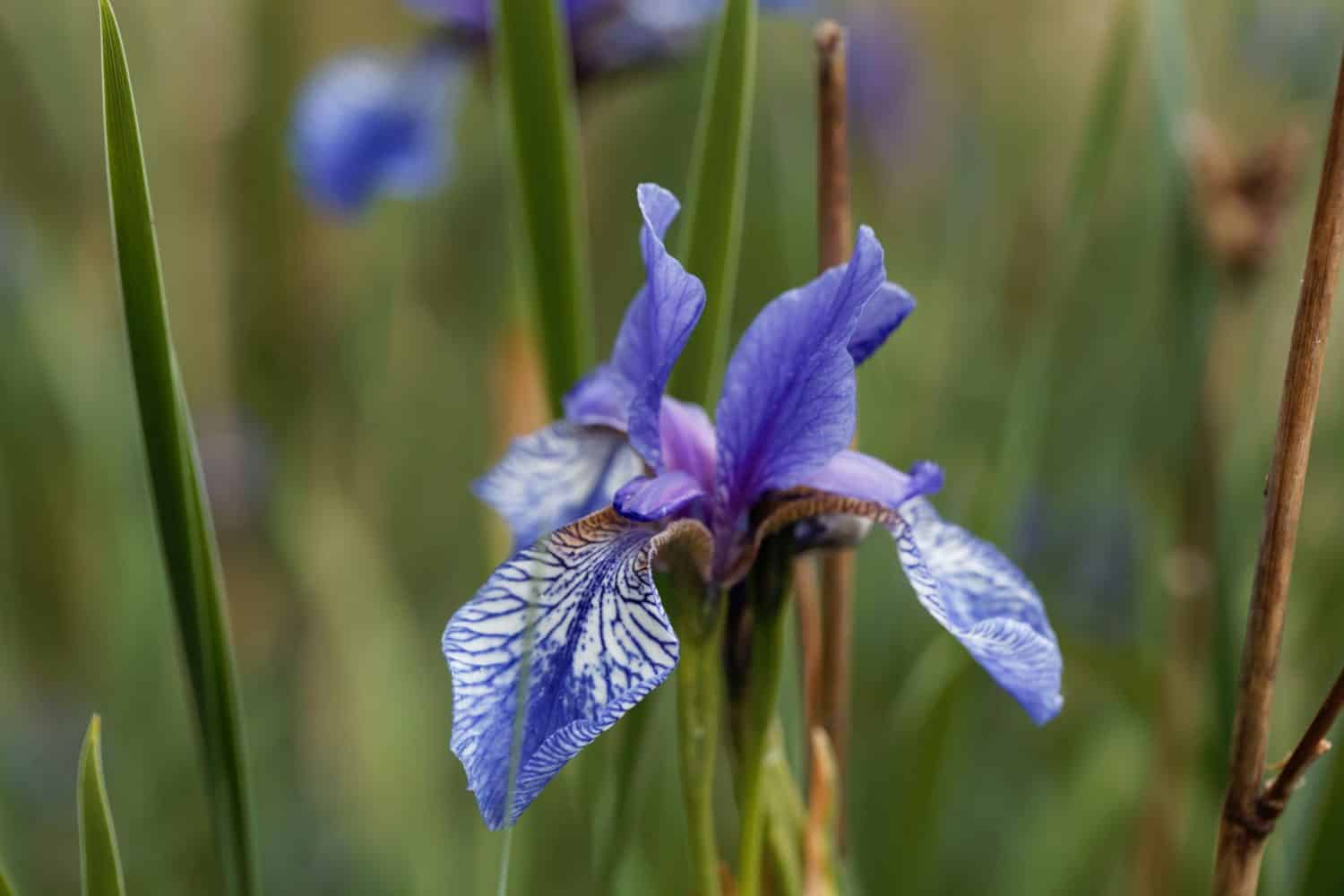
©ChWeiss/Shutterstock.com
Primarily, the coastal iris makes appearances in freshwater and brackish wetlands along the eastern seaboard of the United States. It is quite rare throughout much of its range and appreciates protections from harvest in six states. Strangely, this coastal species has also established populations in Tennessee and northern Alabama.
22. Viper’s Bugloss (Echium vulgare)
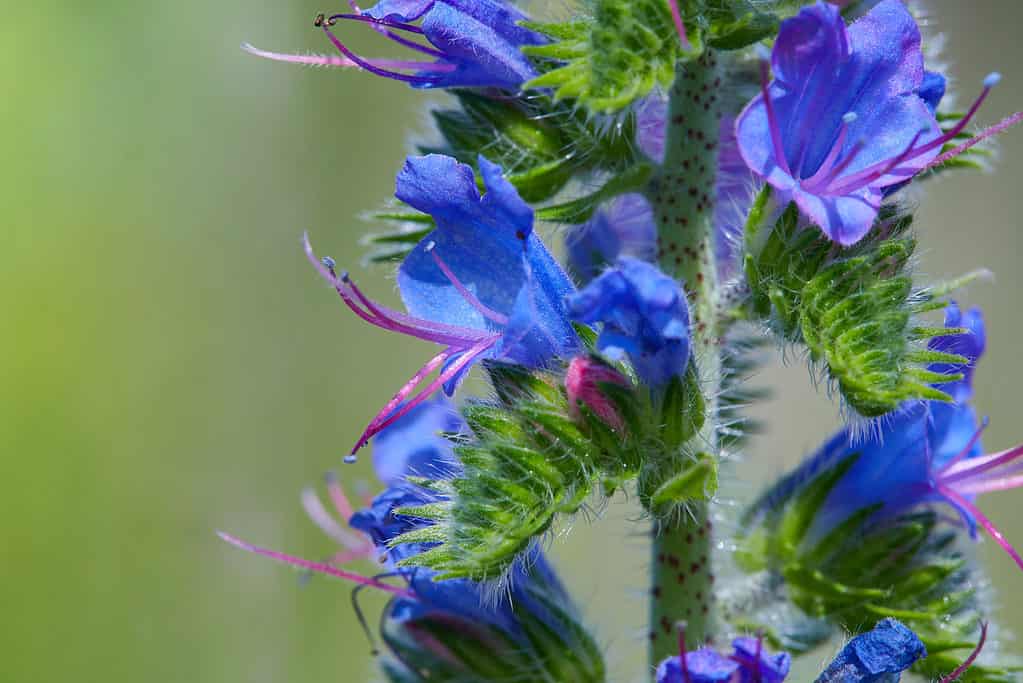
©iStock.com/Liudmyla Liudmyla
This fairly tall member of the borage family is a biennial, usually flowering only in its second year. It is native to Europe and Asia but has become naturalized throughout much of North America. In the summer, from May to September, second-year plants produce long flower spikes that bear a multitude of blue, funnel-shaped flowers. Each flower is speckled with white and, when pollinated, gives way to a tiny nutlet that resembles the head of a viper.
23. Siberian Squill (Scilla siberica)

©iStock.com/Yevheniya Tuzinska
Despite its common name, Siberian squill is native to southwestern Russia, Turkey, and the Caucasus Mountains. It is a low-growing ground-cover plant that produces beautifully nodding, bell-shaped flowers. They are among the first blooms to appear in the spring, producing an ephemeral carpet of blue in the woodland understories they call home. Soon after flowering, as the tree canopy fills in, scillas go dormant until the following spring.
24. Cornflower (Centaurea cyanus)

©EQRoy/Shutterstock.com
Originally a southern European native, these blue wildflowers crop up regularly in agricultural fields, earning them their common name. The species was ferried to North America by European settlers for ornamental purposes and today appears in every U.S. state except for Alaska. Most frequently, they are deep blue. However, their blooms may also be partially or entirely white.
25. Showy Jacob’s Ladder (Polemonium pulcherrimum)
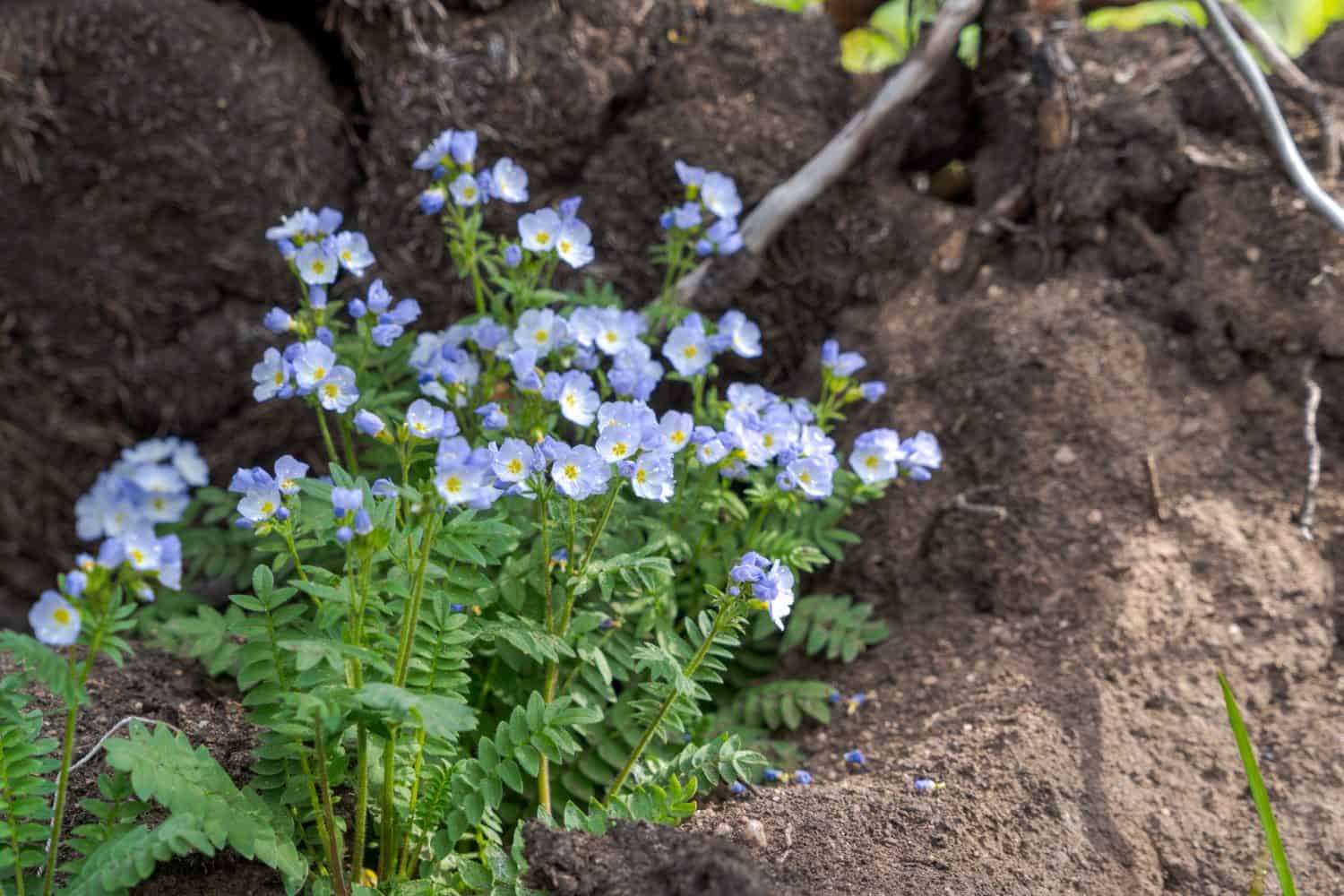
©Jose A Feliciano/Shutterstock.com
This Polemonium species appears throughout the mid- to high-elevation areas in western North America. In the summer, the plant produces clusters of bright blue flowers, each with a brilliant yellow and white center. Like the other members of the genus, this species produces pinnately compound leaves that resemble small ladders, giving them their common name.
26. Borage (Borago officinalis)
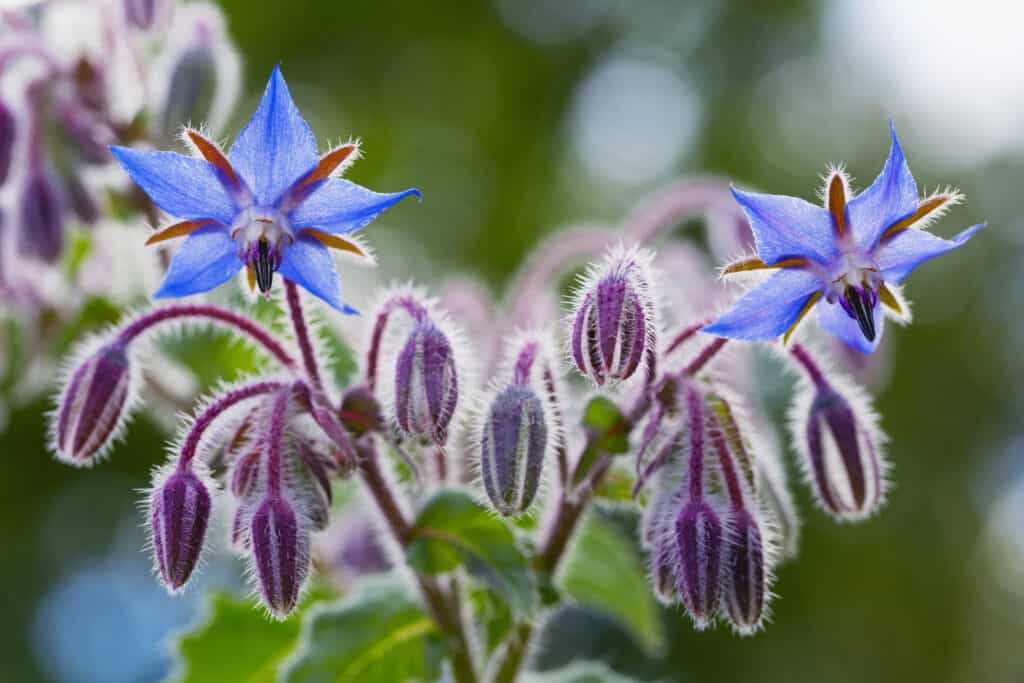
©matteo sani/Shutterstock.com
Also known as starflower, borage produces its flowers in drooping clusters above its bristly stems and foliage. They are quite showy and produce a deep blue dye that can be used to color fabric. Borage flowers and leaves are also edible and impart a delicious cucumber-like flavor to cooked dishes and salads. Though they are edible, they may cause long-term health problems if continually consumed in large quantities.
27. Dwarf Larkspur (Delphinium tricorne)

The blue, white, or purple flowers of dwarf larkspur are complex, bearing most of their color on their five sepals rather than their petals. The much smaller true petals are lightly hairy and rest within the shelter of the calyx, which forms a long spur to the rear of the flower The species appears in the rich woodlands, thickets, and slopes of eastern North America and produces its gorgeous blooms from mid-to-late spring.
28. Climbing Nightshade (Solanum dulcamara)
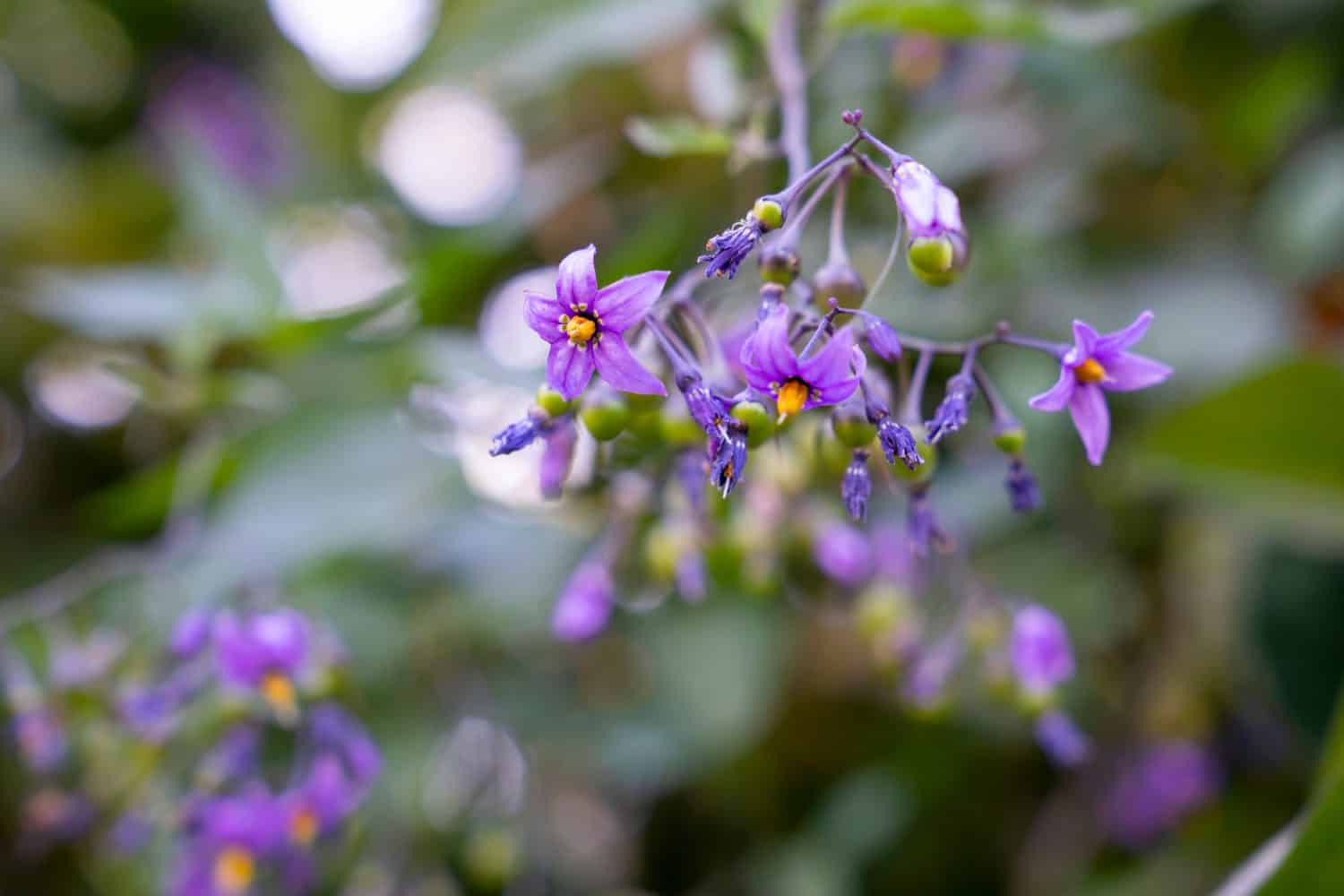
©Bilal Kocabas/Shutterstock.com
This unique wildflower belongs to the nightshade family and is a relative of many familiar edible plants, like tomatoes, potatoes, and tomatillos. Though some of its relatives are edible, climbing nightshade is widely regarded to be poisonous in most of its life stages. In the late spring and early summer, it produces many five-lobed flowers in a delicate blue with bright yellow cones of fused stamens in their centers.
29. Common Selfheal (Prunella vulgaris)

©olko1975/Shutterstock.com
Common self heal, or heal-all has served humanity for centuries as a medicinal herb, with many using it to relieve a sore throat and other ailments. It produces fairly large, cylindrical flower heads late in the summer, each of which bears many tiny, individual flowers. It appears throughout much of Europe, Eurasia, and North America and inhabits a diversity of habitats, from open fields to forest edges and swamps.
30. Ivy-leaf Morning Glory (Ipomoea hederacea)
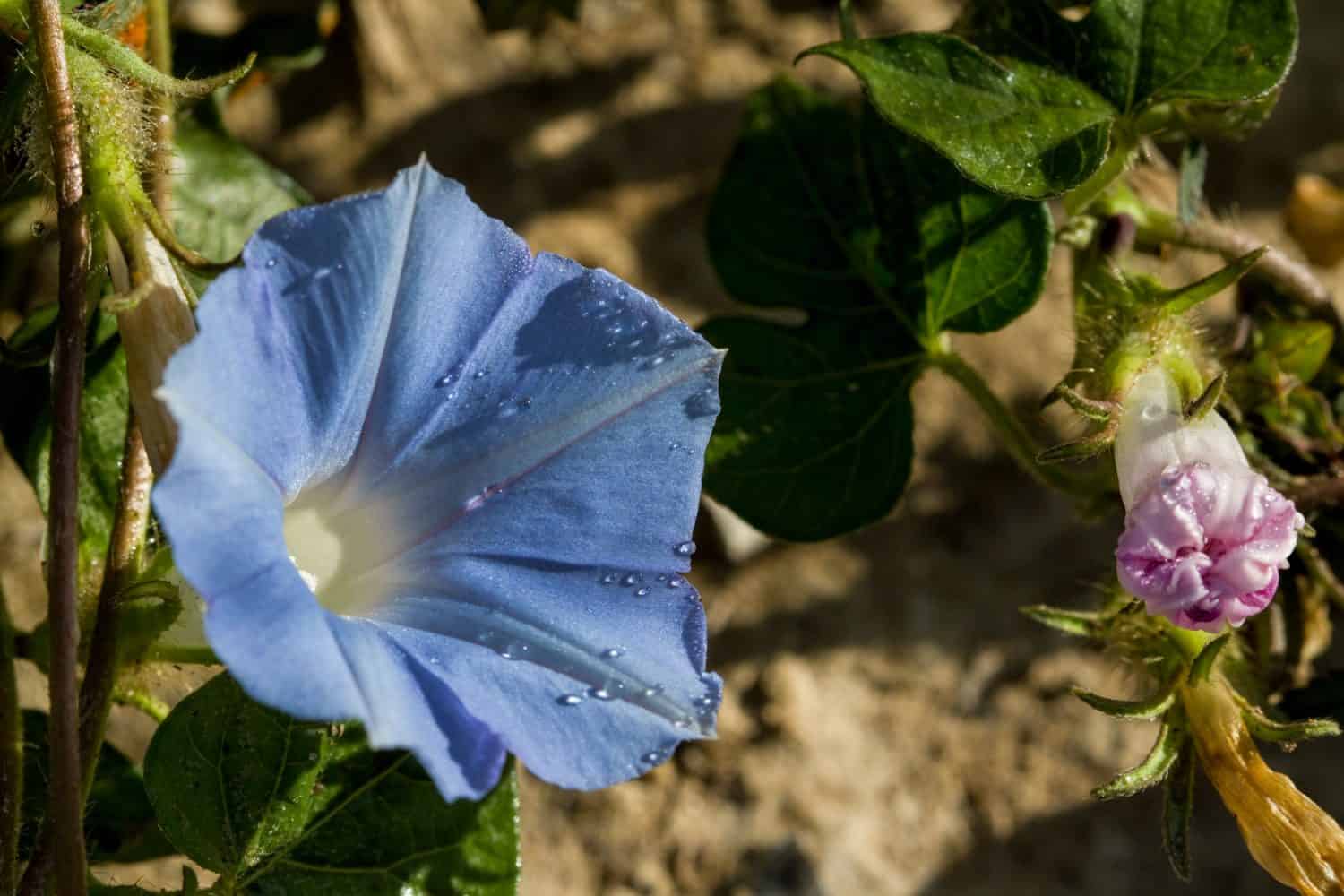
©Kathy Clark/Shutterstock.com
This species of morning glory is one of the most stunning and well-known blue wildflowers. Its bright, trumpet-shaped blooms appear in almost every U.S. state, as well as much of Central and South America. Like other members of its genus, which are relatives of bindweed, the ivy-leaf morning glory is a fast and adept climber. Many consider it an invasive weed in North America, but the plant’s origins are up for debate. Some researchers believe that it may have originated in the southeastern United States.
Thank you for reading! Have some feedback for us? Contact the AZ Animals editorial team.








